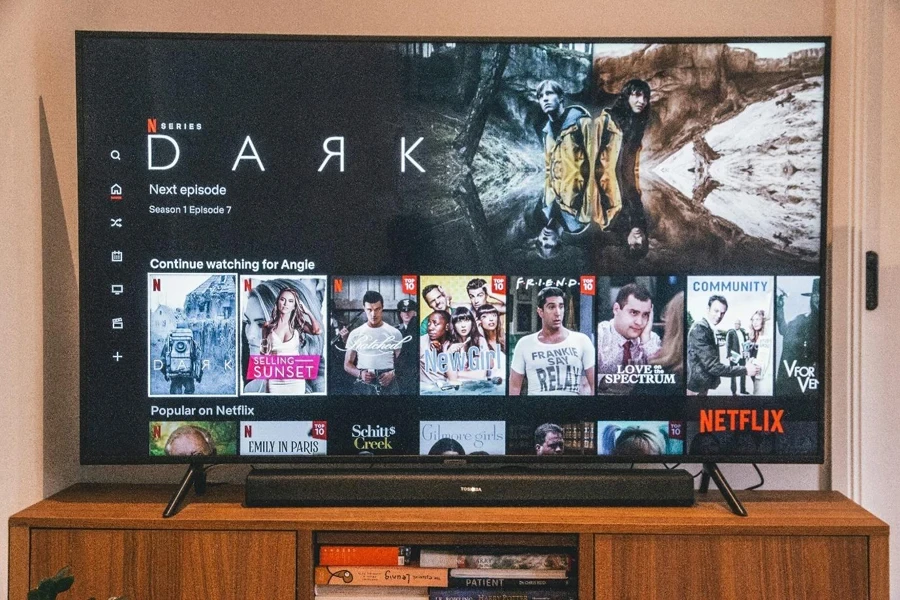In the rapidly evolving world of consumer electronics, Smart TVs have emerged as a crucial category, blending advanced technology with consumer demand for enhanced home entertainment experiences.
Smart TVs have become a key segment in consumer electronics by combining cutting-edge technology with the desire for improved home entertainment experiences among consumers. For professional buyers navigating this competitive landscape, understanding market trends and key innovations is essential to making informed purchasing decisions.
This article delves into the latest developments shaping the Smart TV market, offering insights into cutting-edge technologies and top-selling models. By exploring these trends, buyers can better anticipate consumer preferences and make strategic choices that align with market demands. This knowledge is crucial for staying competitive in Smart TVs’ fast-paced world TVs.

Table of Contents
● Market overview
● Key technology and design innovations
● Top-selling models driving market trends
● Conclusion
Industry Landscape Overview
The global market for smart TVs: Size and growth dynamics
The Smart TV industry has risen in years due to the increasing demand for advanced home entertainment options. As of 2024, the global Smart TV market is estimated to be worth around USD 252.41 billion. It is expected to reach USD 623.62 billion by 2032, with a growth rate of 11.97% based on reports from the industry. The expanding reach of the internet is driving this paced growth, as the rising popularity of streaming services and consumers’ preference for interactive and connected home gadgets.

Market segmentation by technology and region
The market is divided by resolution options and screen dimensions, as the various operating systems significantly influence consumer choices and preferences. 4k UHD TVs hold the majority share in the market at 40%, while it is projected that 8k TVs will experience rapid growth with a compound annual growth rate (CAGR) of about 19% forecasted over the coming decade. Screen sizes ranging from 46 to 55 inches are popular due to the reduced costs and the increased acceptance of 4k technology. Android TV is quite popular among consumers due to its range of apps and seamless integration with Google services; it stands out, along with operating systems like Tizen and WebOS, in the market scenario.
Regional dominance and emerging markets
In terms of geography and market size dominance, by region categories, the Asia Pacific region has a significant share at approximately 38%, with leading roles played by countries such as China and India due to their large population bases and increasing urbanization trends. The Middle East and Africa regions are emerging swiftly as key markets with high growth rates surpassing 12%, driven primarily by improvements in internet infrastructure and increased access to high-quality content. These regions are increasingly gaining significance as they present market expansion and innovation prospects within the Smart TV sector.
Essential Technological and Design Advancements

8K resolution and beyond: Setting new standards
The rise of Smart TVs has brought a wave of quality to the forefront, with 8k resolution taking the lead role in this transformational journey of image clarity enhancement in screens larger than 65 inches and beyond, boasting an impressive 33 million pixels (7680 x 4320). This pixel density offers viewers a good viewing experience by bringing out intricate details and textures that make each frame come to life. Modern 8K TVs are equipped with advanced AI upscaling technologies that utilize deep learning algorithms to enhance lower-resolution content, ensuring that even 4K and HD content is rendered with exceptional sharpness and depth. As the market for ultra-high-definition content grows, 8K TVs are set to redefine the premium viewing experience, offering a glimpse into the future of home entertainment.
HDR and advanced display technologies: The pursuit of perfection
HDR technology has become a component of today’s TVs as it boosts picture quality by heightening the difference between the brightest whites and darkest blacks in images displayed. HDR10, Dolby Vision, and HLG (Hybrid Log Gamma) are available HDR formats with color enhancement and brightness control benefits. OLED screens lead this advancement with self-emitting pixels that deliver good black levels and limitless contrast ratios. On the other hand, QLED technology incorporates quantum dots to create visuals with richer colors that can reach maximum brightness levels of around 2,000 nits. These improvements in screen technologies guarantee that viewers can enjoy content with accuracy and realism, resulting in an engaging and lifelike viewing experience for each scene.
Voice control and smart integration: Seamless user experience
Voice control advancements in Smart TVs have significantly improved user engagement by offering a hands-on, user-friendly experience. Current models integrate features like far-field microphones and natural language processing (NLP). These enhancements empower users to manage their TVs and navigate content using voice commands while controlling home devices seamlessly. Moreover, these Smart TVs frequently act as central hubs in a home setup by smoothly connecting with smart thermostats, lighting systems, and security cameras. Including AI-powered voice assistants has also improved the user experience by providing suggestions and streamlining tasks, ultimately boosting Smart TVs’ overall ease of use and functionality.
Cloud connectivity and smart home integration: Expanding the horizon
The integration of cloud technology has enhanced the functions of Smart TVs by enabling remote access to content and effortless synchronization across various devices. By storing shows and applications in the cloud, users can enjoy on-demand viewing from any device, whether at home or on the move. In addition, Smart TVs have become components of the smart home environment, connecting with systems that manage aspects such as lighting, temperature control, and home security. Modern Smart TVs play a role in today’s living by utilizing IoT frameworks and edge computing technology to provide instant responsiveness and heightened data protection measures as a central hub overseeing entertainment choices and smart home automation for a seamless living experience.
Popular Models Shaping Market Trends

TCL QM8 Series: Leading in 8K brilliance
The TCL Qm 8000 Series is notable for its 8000 pixels resolution and Mini LED backlighting technology that enhances brightness and contrast for detailed picture quality boosters. Equipped with AI upscaling and full-array local dimming, this model suits those seeking visual clarity, even with lower-resolution content.
Hisense U8K: A gamer’s dream.
Gaming lovers highly regard the Hisense UMK as a leading choice due to its features, including 4k resolution and a 120Hz refresh rate with Variable Refresh Rate (VRR). This model guarantees a gaming experience with less delayed responses, and its Quantum Dot technology boosts color precision for an all-around appealing choice suitable for gaming and entertainment purposes.
LG C3 OLED: Seamless smart home integration
The LG C3 OLED is a top choice for people focusing on home integration capabilities. With good black levels and unlimited contrast provided by its OLED display technology, this device also features integrated voice assistants and a user-friendly interface. It is a central control point for overseeing home gadgets, combining high-quality visuals with seamless performance.

Samsung QN90B: The powerhouse performer
The Samsung QN90B combines QLED technology with Mini-LED backlighting to deliver outstanding brightness and color performance. It’s particularly favored for its gaming capabilities, featuring Auto Low Latency Mode (ALLM) and Dolby Atmos support, ensuring an immersive experience for both visuals and sound.
Conclusion
The Smart TV market’s rapid expansion is fueled by innovation in resolution and display technologies alongside integration advancements that set standards for home entertainment. The top models explore frontiers by delivering state-of-the-art features tailored for gaming performance and seamless integration with smart home devices. These creative developments improve the viewing experience and position Smart TVs as essential hubs in contemporary connected households, maintaining a dynamic and competitive market landscape.




